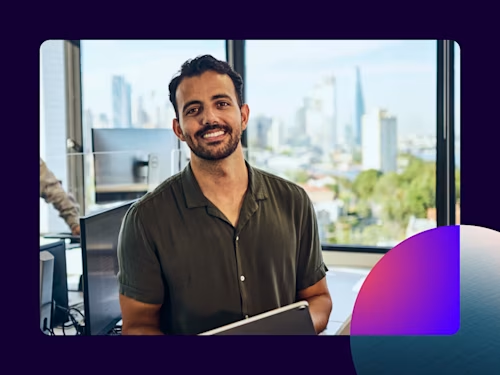
Adopting sustainability practices: How businesses can balance risk and opportunity
Sustainability is a key priority in business today, we invited Virginia Trioli to pick the brains of global sustainability experts and business leaders.

How can you become a more sustainable business? This question is now top of mind for businesses large and small. And, while there’s no single answer (it’s a big question, after all), there are plenty of great people thinking up and sharing their solutions. Docusign recently invited some of these incredible thinkers and doers to a webinar on adopting sustainability practices, hosted by esteemed Australian journalist and author Virginia Trioli.
The webinar explored how businesses can take real steps to meet ESG requirements, while avoiding obstacles along the way. Let’s take a look at the key points coming out of the session (or, you can catch up on the full webinar).
Sustainability is firmly in the spotlight
The first key point coming out of the webinar was that sustainability is no longer just a ‘nice to have’. It’s a business imperative. Attitudes have changed significantly in the past decade, with companies that rank well on ESG metrics consistently outperforming the rest of the market.
Globally respected sustainability author John Pabon cited some impressive statistics to illustrate this. “According to the New York Times, employees at purpose-driven companies have higher engagement and job satisfaction. They tend to stay at their company around three times more than in companies that are not purpose-driven,” he said.
Sustainability reporting and disclosure are increasing globally. “In 2011, only about 20% of companies were reporting on ESG. By 2020, that number reached 90%. Today, about 96% of all companies are reporting on sustainability performance,” said John.
PropertyGuru CEO Hari Krishnan, who is based in Singapore, agreed. Hari has seen opinions change dramatically in recent times. Major climatic events like flooding and high pollution have made people sit up and take notice. “We’ve been polling consumers for a decade about the property sector. During the Covid era, for the first time, we saw sustainability come to the fore, unprompted. In fact, 82% of Sinaporeans will pay more for a home that is sustainable. When people are willing to pay more, it’s an indication of change.”
Governments and investors have noticed the shift in how organisations are approaching ESG, too. In other words, if businesses don’t do anything about sustainability, they will simply get left behind. Sustainability makes solid business sense.
Getting to green can be challenging
We all know we need it. Yet achieving sustainability can be hard for businesses. For large businesses, there are complex systems and supply chains to grapple with. For small businesses, a lack of resources and skills can hold you back.
John pointed to three key challenges that typically hold businesses back: the absence of a C-level champion of change; trying to do too much, too soon; and taking a ‘short-term’ approach instead of holding true to long-term goals.
On this last point, he said, “There’s a difference between a ‘short-termism’ mindset and long term vision. Short-termism is the awful result of quarterly performance requirements by boards. Unfortunately, sustainability is not short term. The changes we want are long term by nature. We need a better balance. And more mature organisations are starting to link sustainability performance as a KPI at the board level.”
Canva’s sustainability lead, Jared Ingersoll, added another challenge. He said, “The problem can feel daunting. How do you get the right information to the right stakeholders? There’s a lack of clarity around what steps need to be taken.” As he said, to get executive buy-in, you need to work hard to overcome a lack of understanding or skewed perspective on risk.
Technology helps remove sustainability roadblocks
Kate Pounder, CEO of the Tech Council of Australia, was our self-confessed ‘glass half full’ panelist. She spoke of the opportunities for businesses to leverage technology to help solve some of the challenges getting in the way of sustainability.
“Any business that wants to reduce its environmental impact first needs to know what the impact is today, and which impacts they can influence. Is it carbon emissions, waste, pollution, the supply chain? We know these impacts vary by industry, country, and business size. There are an increasing array of tools to help businesses understand the impact they’re having, and the levers they can influence,” she said.
Indeed, technology is a driving force behind helping businesses build more sustainable supply chains and operating models. As Hari said, technology is an enabler for transparency and efficiency, more measurability and a data mindset. “Digital transformation is about continually learning. You measure things, get it wrong, learn and grow. It doesn’t take away from your core mission, but perhaps you can find ways to do it more efficiently.”
And, with technology, you can start small. For example, Kate recommended a great place to start with becoming more sustainable is by digitising the document execution process. She pointed out that, if small businesses move to digital document execution, it would save around $400 million per year across the economy – not to mention the environmental benefits.
Sustainability starts now
Sure, making green choices can feel confusing. But sustainability can’t be ignored. As Kate said, “We have to act and manage our environmental impact. And, to prepare, act sooner rather than later.”
And, as John said, it’s no longer acceptable to simply sign a cheque to charity. Every business needs to take action, starting small and achieving incremental wins – not just for themselves, but for the planet.
If you’d like to hear the whole conversation, you can catch up now. Or, for a chat about how you can embed more sustainable practices into one aspect of your business – document execution – get in touch today.
Docusign IAM is the agreement platform your business needs


